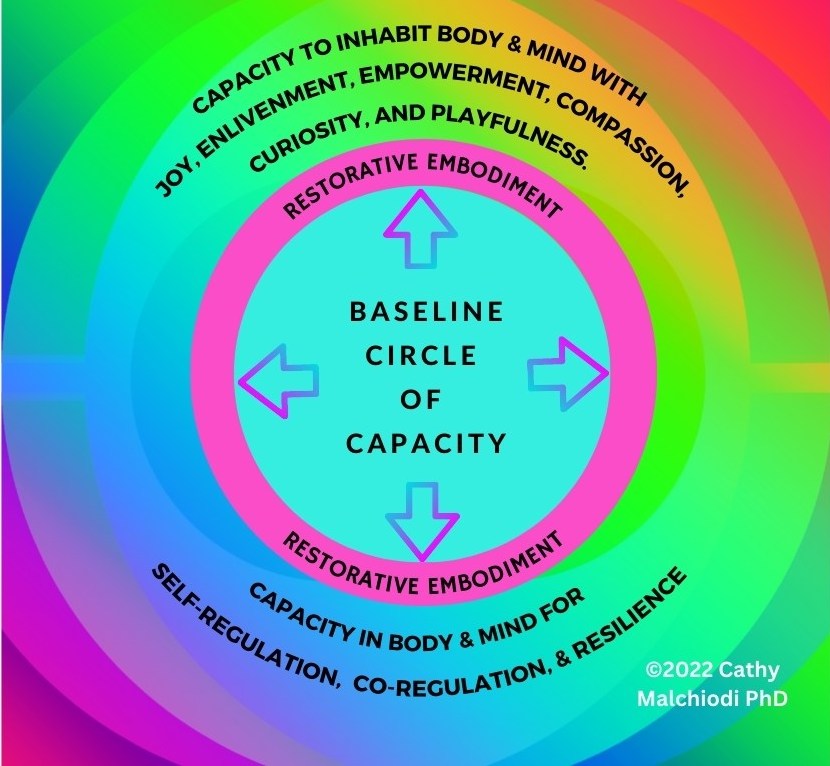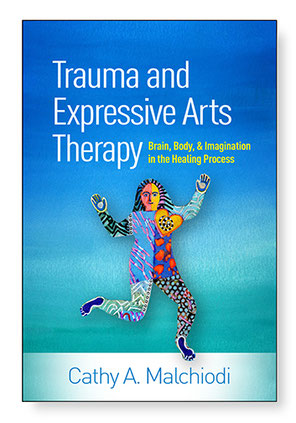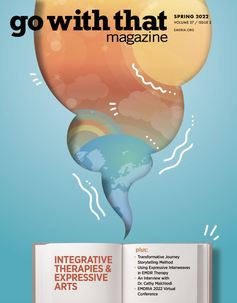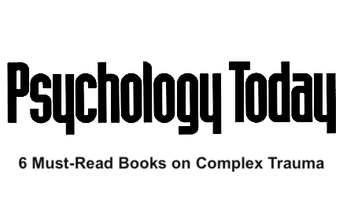Cathy Malchiodi, PhD, LPCC, LPAT, REAT
The Body Holds the Healing
Expressive Arts Therapy and Integrative Somatosensory Psychotherapy in Trauma Healing and Recovery
"Neurobiology has taught us that we need to “come to our senses” in developing effective components for addressing trauma...Expressive arts therapy releases the potential of the senses to “tell the story” of traumatic experiences via nonverbal, implicit forms of communication."
"Expressive arts help people discover just what forms of expression will be self-regulating, communicate their experiences in reparative ways, imagine restorative narratives, and ultimately support recovery."
"The expressive arts have a unique role in restoring a sense of vitality and joy in traumatized individuals because aliveness is not something we can be “talked into.” Instead, it is experienced in both mind and body and particularly on a somatosensory level."

Cathy Malchiodi, PhD, LPCC, LPAT, REAT holds a doctorate in psychology and is an expressive arts therapist specializing in the treatment of traumatic stress. For the last three decades Cathy has worked with traumatized children, adolescents, adults, and families, expanding the range of understanding of non-verbal, sensory-based concepts and methods. She is the executive director of the Trauma-Informed Practices and Expressive Arts Therapy Institute that has provided online and live training in expressive and somatosensory approaches to over 35,000 practitioners around the world.
Cathy is the 2022 Cecil and Eda Green Honors Chair on trauma and expressive arts and is an investigator in a 3.7-million-dollar, five-year grant with the US Department of Education, integrating expressive arts therapy into classrooms. A popular presenter and workshop leader, she given over 700 invited keynotes and workshops throughout the US, Canada, Asia, Europe, the Middle East, and Australia. She has authored 20 books, including the bestselling Trauma and Expressive Arts Therapy: Brain, Body, and Imagination in the Healing Process and Understanding Children’s Drawings. Her publications have been translated in over 20 languages.
Dr. Malchiodi has extensive experience in the areas of trauma, attachment, disaster relief, and adversity. She has assisted more than 500 agencies, organizations, and institutions in developing trauma-informed, expressive, and responsive programming including the World Health Organization, United Nations, Department of Defense, Kennedy Center, Harvard, MIT, Johns Hopkins, and numerous universities, mental health, community, and healthcare agencies in the US and throughout the world. Widely interviewed by a variety of news outlets, she has been featured Time Magazine, CNN, Cosmopolitan, Natural Living, Marie Clare, Australia Childhood Foundation, US News and World Report, and VICE, among others. She is a contributing writer for Psychology Today and has a readership of approximately 5.8 million on topics relevant to trauma recovery and restoration of the self, arts in healthcare and mental health, and self-care.
To book a keynote, presentation, workshop, or training, please contact us via the Contact page.

The Body Holds the Healing (Malchiodi, 2022).
In contemporary psychotherapy, the term embodiment has taken on a slightly different meaning. Many therapists are now familiar with the idea that the “body keeps the score” (van der Kolk, 1994; 2014). “Our issues are in our tissues” (author unknown) is another phrase often used by somatic educators and body-based practitioners (yoga, massage, and others) to describe the importance of physical awareness.
These ideas influenced the definition of embodiment and what has become known as embodied practices, particularly within the field of traumatic stress. These practices underscore the importance of observing and noticing one’s internal felt sense. Embodiment implies that the central focus for emotional repair, transformation, and recovery is through becoming aware of our physical being through the senses. It is a way to include the body as a focus for health and well-being through self-appreciation and self-acceptance of what we physically sense and feel in the moment (Malchiodi, 2020).
This perspective also proposes that embodiment is not just a one-time event but is an ongoing practice of establishing a relationship with one’s body. It involves various mind-body awareness approaches (see Somatic Experiencing® or the fields of expressive arts therapy or dance/movement, for example) to sustain attention to how one’s body responds and feels in the present moment. Read more here...
FEATURED IN THE TRAUMA THERAPIST NEWSLETTER

From The Trauma Therapist Newsletter: "Cathy is one of those forces of nature within the field of trauma and Expressive Arts. So much so that she's not only our "cover" therapist, she's also representing out Modality section. Here's Cathy in her own words: 'As a psychologist and expressive arts therapist who works with trauma and grief recovery, my goal is to help individuals, groups, and communities resource implicit forms of communication for repair and healing. Words are not always available when we embody narratives of suffering, shame, guilt, and loss, either on an individual level or a collective one.
Fortunately, as humans we all have the ability to access ways to communicate and transform distress, trauma, and loss and in uniquely powerful, yet simple ways. These approaches include deceptively simple pathways to healing -- restorative movements, soothing sounds and rhythms, image making, enactment and improvisation, and sensory integration to support body, mind, and spirit. When used in combination—the essence of expressive arts therapy—these universal practices tap deeply embodied sources of health and well-being.'
FEATURED IN MEDIA AND PRESS:

New film on why rhythm is foundational to secure attachment and social connection
Expressive and sensory-based approaches are not "activities therapy"-- they are approaches grounded in trauma research and best practices. Current studies in the field of psychological trauma underscore that sensory processing is foundational to supporting survivors in recovering body awareness. This "bottom-up" approach is one way to address a lack of words to express internal (interoception) when traumatic stress disrupts cognitive and somatic perceptions. Enjoy this recent film and lecture with Dr. Cathy Malchiodi.
Learn More About the Circle of Capacity Model

Circle of Capacity-- Model for Trauma Intervention | Cathy Malchiodi, PhD
What if increasing capacity became the dominant objective rather than simply expanding the ability to tolerate distressful reactions? As an expressive and experiential practitioner, I see trauma repair and recovery through the exploration and discovery of capabilities in contrast to simply widening a window of tolerance. The self is not necessarily restored through increasing the ability to tolerate reactions, but through supporting tangible, sensory, and somatic experiences of efficacy, resourcing, and resilience.
This is a transformation felt in the body as the capacity for action, empowerment, mastery, and confidence when encountering distress and disruptive events. In other words, expanding tolerance may help an individual more effectively cope with distressing reactions. But in order to truly repair and recover, expanding capacity involves something beyond enduring and coping. It requires identifying and practicing experiences that begin to replace hyperactivation and/or hypoarousal in body and mind.
You can read more about this model at Psychology Today where Dr. Malchiodi is a Contributing Writer at this link
Join Our Certificate Trauma-Informed Expressive Arts Therapy Trainings Online!
Our Learning Center provides continuing education courses for psychotherapists and counselors who want to add expressive methods to their practices; for coaches and educators who want to learn more about how to include the healing arts in their work; and body-based practitioners who want to combine somatic approaches with additional knowledge in expressive arts. You can complete Level One or Level Two Certificates through online coursework or live webinars. Or you can complete our course sequences to achieve the EXAT [Expressive Arts Therapist, Trauma-Informed] for psychotherapists and mental health professionals or the EXA-CE for those practicing as coaches, educators, facilitators, or body-based practitioners. Please visit our Learning Center or the Trauma-Informed Practices and Expressive Arts Therapy Institute for more information.
Trauma-Informed Expressive Arts Therapy

Trauma-Informed Expressive Arts Therapy and Trauma-Informed Art Therapy® are approaches developed in 2011 by Dr. Cathy Malchiodi that integrate trauma-informed practices, "brain-wise," body-based expressive arts approaches. They facilitate self-regulation and co-regulation; an embodied sense of safety; reparative relationships; and communication of implicit and body-based experiences. To learn more about these psychotherapeutic approaches, please visit the Trauma-Informed Practices and Expressive Arts Therapy Institute for online courses, certificate programs and trainings throughout the US and the world [see Trauma-Informed Practices and Expressive Arts Therapy Institute website]. The Institute offers professional development and continuing education for mental health professionals and master's and doctoral students and emphasizes integrative methods and current research in expressive arts, creative arts therapies, and trauma-informed care and complements somatic, sensory integration and neurobiology-informed methods of trauma intervention. Expressive arts therapy is the purposeful use of multiple arts forms to support individuals' trauma recovery The Institute supports a vision for advanced understanding and education in these methods of psychotherapy and promotes the value of these approaches as complementary to trauma-informed care, psychotherapy and wellness practices.
HEALING THE MIND WITH THE IMAGINATION: BEYOND THEORY. View or listen to Season 2, Episode 11: After experiencing trauma, it can be challenging to start talking about what happened. But one way to overcome that is to find other ways to express yourself. So as an art therapist, how does Dr. Cathy Malchiodi use color, sound, and movement to help people tell their stories and start to heal?

Articles and Interviews

Psychotherapy Networker, March/April 2018, Ryan Howes, PhD: "To bring myself up to date, I reached out to Cathy Malchiodi, a Kentucky-based art therapist and author of more than 20 books on the topic, including The Art Therapy Sourcebook and the recently released, What to Do When Children Clam Up in Psychotherapy. As president of Art Therapy Without Borders and founder of The Trauma Informed Practices and Expressive Arts Therapy Institute, Malchiodi has her finger on the pulse of the profession and is at the forefront of a growing movement to treat returning combat veterans with art and expressive art therapy." See this link for the rest of the interview.
Slate.com, Rebecca Bloom: Dr. Malchiodi's interview with Slate on "The Devil Is in the Doodles." Pop culture is full of kids who reveal their inner demons by drawing creepy pictures. Does that happen in real life? To read more, see this link.
Kindling the Spark: The Healing Powers of the Expressive Arts in Psychotherapy Networker, March/April 2019. This article will give you an overview of how the expressive arts are integrated within the context of psychotherapy.
A 2020 Vision for Expressive Arts Therapy. On Psychology Today, an article by Dr. Malchiodi about expressive arts therapy. "By definition, expressive arts therapy is a field of practice that emerged in the latter part of the 20th century. In contrast to individual applications of specific art forms [visual art, music, dance, drama] in psychotherapy, expressive arts therapy is understood as the use of more than one art form, consecutively or in combination and depending on individual or group goals. In other words, one art form may dominate or multiple forms may be introduced in work with a child, adult, family, or group."
Photo Gallery of Recent Keynotes, Trainings, Events and Projects














































































































